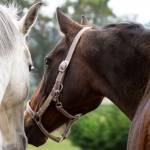Lymphosarcoma in Horses

Lymphosarcoma derives its name from the transformation of normal lymphocytes to neoplastic or cancerous cells. In a healthy horse, lymphocytes are responsible for determining the specificity of the immune response to foreign microbes. Unchecked growth of neoplastic lymphocytes results in lymphosarcoma. Though horses of all ages have been diagnosed with this specific malignancy, the majority of cases occur in horses between the ages of 5 and 10.
Lymphosarcoma may be classified into four distinct types, based on location: generalized, mediastinal (thoracic cavity), intestinal, or cutaneous (skin). In one retrospective study of 57 cases over a six-year period*, pathologists found generalized lymphosarcoma to be the most prevalent type, comprising 37% of the cases, with intestinal lymphosarcoma proving to be the least common at 8%.
Clinical signs of the disease may descend upon horses progressively or abruptly. Certain signs are due to direct permeation of organs by neoplastic lymphocytes, including obstructions caused by malignant masses. Other signs are body-wide: depression, fever, ventral subcutaneous edema, anemia, swelling and pain in lymph nodes, and chronic weight loss. Signs depend largely on the affected organ system. Intestinal lymphosarcoma, for example, might cause a horse to have recurrent colic, diarrhea, and concomitant loss of body condition.
Diagnosis of lymphosarcoma is typically made through microscopic identification of neoplastic lymphocytes in body fluids, fine-needle aspirates, or excisional biopsies. Supportive therapy for horses diagnosed with lymphosarcoma includes chemotherapeutics, hormones, immunomodulators, and corticosteroids.
“From a nutritional perspective, changes in diet should be dictated by appetite. If the horse can withstand his normal diet, one based primarily on forages and supplemented with concentrates and possibly supplements, this should continue,” advised Kathleen Crandell, Ph.D., a nutritionist with Kentucky Equine Research (KER).
“If the appetite remains healthy but weight loss is apparent, introduction of high-fat supplements might help and could include vegetable oil (soybean, canola, corn) or stabilized rice bran. Choices might be limited if intestinal lymphosarcoma is diagnosed, as certain feedstuffs may worsen colic or diarrhea,” she continued. A veterinarian and nutritionist might work together to formulate a diet that works best for the horse and its individual clinical signs. Appetite might decline with disease progression, explained Crandell, and when this occurs, the horse should be offered whatever forage it will eat, in whatever quantities are necessary.
Once clinical signs are noticed, the horse is likely in a state of significant debilitation, and the long-term outlook for the horse is grim. Most horses succumb within six months of declining health. Those diagnosed with subcutaneous lymphosarcoma seem to live longer than horses with other forms of the disease.
*Loynachan, A. 2016. Equine Lymphosarcoma. In: Equine Disease Quarterly. University of Kentucky Department of Veterinary Science. 25(1):5-6.








